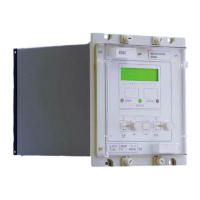VCG202/EN M/H11
Technical
Figure 16: Negative reactance control 2
Figures 15 and 16 mimic Figures 13 and 14 except that in this case all the compensation
elements which are reactive have been reversed, the resistive elements being
unchanged. It can now be seen that the transformer with a low volts condition is
presenting a regulating voltage Vreg which is lower than Vrem (the required voltage) and
hence a raise volts command is given. The opposite is true for the transformer that has
too high a voltage. The net result is that the transformers are forced together eliminating
the circulating current.
Where negative reactance control is used it should be noted that the setting applied to
the relay is now based on the transformer reactance and not the line reactance to enable
correct compensation. This will introduce an error in regulation which can be seen in both
Figures 15 and 16. In both cases when the circulating current is zero the relays will
regulate to Vrem. This value of Vrem is different to that from Figures 13 and 14 (also
shown as dotted lines on Figures 15 and 16). In practice this error is very small for a unity
power factor load current.
The above diagrams demonstrate how reverse reactance control is used to eliminate
circulating current. All the above figures also assume that line drop compensation is
being used as well. This is not necessarily the case. If LDC is not required then the
resistive compensation will not be needed and can be set to zero and only the reactive
compensation will be set (in the negative sense). Figure 17 shows this arrangement and
assumes that the reverse reactance compounding has eliminated the circulating current.
It is noted from the figure that load current will still be passing through the reactive
compensation circuit producing a certain amount of compensation (where none should be
present). In effect this load current compensation is purely an error signal. Again, in
practice this error is small.
Figure 17: Negative reactance control at unity power factor
Figure 17 shows the effect of load current on negative reactance control with a unity
power factor. Where the power factor is not unity then it is possible to use the resistive

